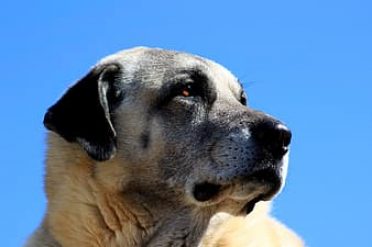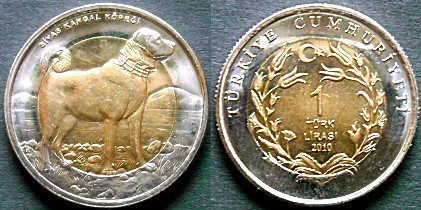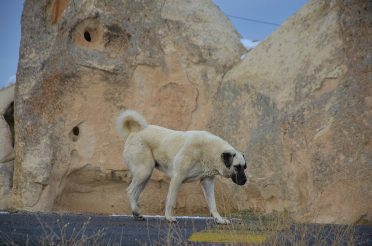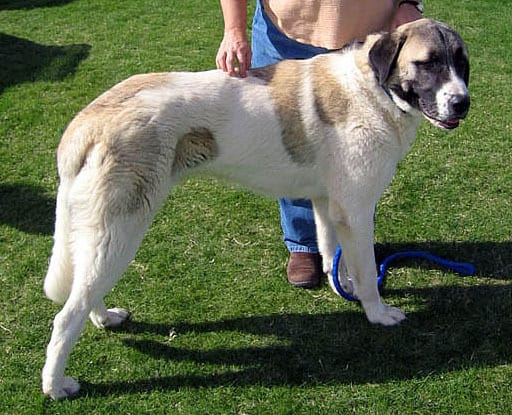This page contains affiliate links. We may earn money or products from the companies mentioned in this post through our independently chosen links, which earn us a commission. Learn More
 The Kangal Shepherd Dog is a guardian dog breed that originated from Sivas, Turkey also known as Turkish Kangal or Anatolian Kangal. It’s a large dog breed at about 28 to 34 inches tall, weighing anywhere between 90 to 150 pounds. The average lifespan of the Kangal Shepherd is around 13 to 15 years.
The Kangal Shepherd Dog is a guardian dog breed that originated from Sivas, Turkey also known as Turkish Kangal or Anatolian Kangal. It’s a large dog breed at about 28 to 34 inches tall, weighing anywhere between 90 to 150 pounds. The average lifespan of the Kangal Shepherd is around 13 to 15 years.
With its roots in Turkestan, the Kangal comes from an ancient lineage of mastiffs (just like another huge dog Pakistani Mastiff AKA Bully Kutta), guarding livestock such as sheep against large predators.
Despite its intimidating stature and protective tendencies, look into those big, droopy brown eyes and you’ll see the Kangal for what it truly is: a gentle giant with an undying love and loyalty for its human(s). Could this giant be the perfect four-legged addition to your family?
Let’s dive into the world of Kangals and review the characteristics that make up this beautiful breed of dog.
Contents & Quick Navigation
A Bit of Kangal History
Once upon a time, farmers from the Kangal District of Sivas Province in Turkey faced a major dilemma. The constant impending danger their livestock faced from top-tier predators, such as wolves and bears, was reducing the numbers of their flocks.
They needed a hero, someone with immense strength, agility, and intelligence. But where could they find such a candidate to go up against, say, a monstrous hungry bear?
That’s when the Kangal sheepdog made its debut (similar to Caucasian Mountain Shepherds who were also bred to protect flocks from wolves), as the prized shepherd dog of the Aga of Kangal.
This prosperous family was comprised of landholders and chieftains, who utilized the Kangal’s extraordinary strength to protect their flocks. Word of the Kangal’s defensive skills spread, prompting other villagers to breed their own.
Cross-breeding was not an issue in this region. Interestingly, Muslims are not permitted to keep animals in the house, so Kangal dogs are rarely found at home with families in Turkey.
Instead, they stay out on the plains with the flocks. This isolation helped Kangals retain a strong, pure bloodline, exemplified in their unwavering, cool disposition and streamlined appearance.

The Kangal dog has long been heralded an icon of the Turks, treasured as the national dog. Its muscular body adorns Turkish stamps and coins, and breeding kennels are held in the highest esteem, maintaining immaculate pedigrees.
What Does a Kangal Look Like?
 The Kangal is truly a magnificent specimen, standing tall with a muscular build that has evolved over time to accommodate harsh climates and rough terrain.
The Kangal is truly a magnificent specimen, standing tall with a muscular build that has evolved over time to accommodate harsh climates and rough terrain.
It is indeed a giant dog, but not as large as other mastiff breeds. Years spent shepherding livestock across vast expanses of land have helped the Kangal to naturally finetune its agility and speed.
A wide head that is a bit lion-like is accompanied by velvety drop ears and the body is long with a curled tail.
Coat: The Kangal sports a short, double coat of thick fur that is a sandy color, while its face sports black fur that resembles a mask. Its ears are also tinged in black fur. It is not uncommon to find a few white markings on the chest, chin or toes, but otherwise, a true Kangal won’t exhibit any other color patterns, such as brindled.
Height & Weight: A male Kangal can weigh up to 143 lbs (65 kg) and can grow up to 34 inches (85 cm) in height while a female Kangal can weigh up to 121 lbs (55 kg) and can grow up to 29 inches (75 cm) in height.
Fun Fact: Kangal dogs can also sport cropped ears. This is done because some believe that cropping allows sound to travel into the ears easier, improving hearing. Keep in mind that ear cropping is quite controversial, and is actually banned in the UK.
What Are the 4 Top Traits of a Kangal?
1. They are pretty darn smart
Kangals were bred to be vigorous and attentive. With their knack for shepherding they are quite intelligent, keeping a watchful eye on approaching danger and learning about its surroundings quickly.
With a Kangal, you’ll have a dog that thinks like a pack leader, and as its human, you are a cherished member of its pack. As with most breeds, training is most beneficial when started from a young age and must be kept up going into their adult lives.
2. Kangals are family dogs
Although they might get testy if an unfamiliar dog saunters up for a sniff, don’t worry too much- this is just those hardwired shepherding genes at work playing guardian.
When it comes to human interaction, Kangals are known to be friendly and gentle, including around children.
3. They can handle being alone
From years spent traversing the wilderness of rural Turkey without human guidance as it guards the flocks, the Kangal dog has developed a strong sense of independence.
If you have to run out for groceries or want to grab a coffee, this breed does well on its own.
4. They’re built tough
A hardy dog, as mentioned in the first paragraph the Kangals lifespan numbers 13 to 15 years. Just be sure to provide this dog with the physical and mental stimulation it needs. It’s a big dog that enjoys time outdoors to stretch those long legs in a wide, open environment.
Check out this video that showcases the Kangal’s impressive size and power.
So, Just How Strong is the Kangal Dog?
Strength is what this breed is known for, and remains a hot topic among canine enthusiasts. The Kangal bite force is said to be the strongest of all dog breeds. Their bite has been measured at 743 PSI!
Don’t fear though, as these dogs are not bred to be unpredictably aggressive, only showcasing their immense power when taking a protective stance over the pack.
With the crown for the strongest dog bite, it’s only natural that a discussion regarding worthy opponents would crop up that seeks to challenge this Hercules-esque legacy. Let’s take a look at some of the most interesting comparisons in the animal kingdom.
Kangal vs Wolf: Can a Domesticated Dog Dethrone the King of the Wild?
In Turkey, farmers cherish the Kangal and its ability to protect livestock from wolves. From the time they are puppies, training begins with a wolf pelt to smell, in order to become familiar with their future nemesis.
As adults, it’s common to see working Kangals sporting a spiked collar, which protects them from wolf bites. The spiked collar is much needed, as a wolf harnesses a bite force of around 400 PSI. It is said that a large wolf can bite down with 1,200 PSI if protecting itself.
Regardless, The Kangal’s eagerness to defend, intelligence and attentiveness put them on the same playing field as a wolf, especially after spending most of its working life in wolf territory. As well, they have been known to kill wolves. The Turks say that a successful dog is one that has “strangled a wolf.”
In the modern age, flocks in Turkey have dwindled with the rise of industrialized farming, and so then has the threat of wolves.
It’s becoming more uncommon to witness a Kangal and wolf battle. But, with its strapping size, incredible speed, and bone-crushing bite, we’re pretty sure a Kangal fits the description as a wolf’s worst nightmare.
Kangal vs. Lion: The Ultimate Dog and Cat Rivalry
Legend has it that during the time of the Assyrians, the first Kangal was bred from a Lion (just like Thai Ridgeback). How so, you ask? Well, take a look at that lion-like size and bite. Ok, so maybe it’s only a legend, but in ancient times, this power pooch was supposedly used for protection against lions, wolves, and bears.
Today, battles against lions is left to shepherd storytelling under the stars, but in real life, the Kangal is being used to protect against another big cat.
Since 1994, around 500 Kangal dogs have been given to farmers in Namibia by the Cheetah Conservation Fund in an effort to protect livestock from Cheetah attacks and hopefully lower the rate of cheetahs killed by farmers.
The experiment was a success! The size and strength of the Kangal dog along with its acute guarding capabilities helped reduce the killing of farm animals and cheetahs, and the project has now spread into Kenya.
So, if a Kangal can go up against a cheetah, can it take on the jaws of a lion? A cheetah has a bite force of 475 PSI while a lion has a bite force of…a whopping 1,000 PSI! It’s safe to say that as impressive as the Kangal is, it might have met its match with a lion.
Kangal vs Pitbull: Jaws of Steel Clash in the Canine Kingdom
The American Pitbull Terrier is another dog breed known for its muscle power and terrifying bite. Although its bite force is only 235 PSI, it’s those monster jaws and unpredictable temper that have earned them one of the most feared reputations when it comes to dangerous breeds.
A Kangal dog has a much stronger bite force at 743 PSI, so it’s safe to say that it could take on a Pitbull. Unfortunately though, if these two dog breeds were to meet, it might be under most desperate circumstances. Both breeds are widely used for the appalling and inhumane practice of dog fighting.
In the US, the pitbull is the popular dog of choice for fighting, and in Turkey- it’s the Kangal. A lucrative blood sport, the use of Kangal dogs is becoming more prevalent, resulting in dire consequences.
Since the Kangal is naturally a defensive dog, cross-breeding is done on purpose to disrupt temperament and increase aggression.
Steroids and drugs are also introduced to inflame behavior. This has muddled the preservation of a pure bloodline, as well as tarnished the Kangal’s iconic image as the country’s national treasure.
How can you stand up against the evils of dog fighting? Even the smallest action can make a big difference for a dog’s life in the long run. This informative guide by the Humane Society is a good place to start.
Are Kangal Dogs a Recognized Breed in the US?
As the Kangal grows in popularity, so has careless breeding practices, especially when geared towards dogfighting. In an effort to preserve this magnificent breed, Turkey has banned the export of Kangals. The few officially recognized breeders in Europe and North America are impassioned devotees to this dog’s legacy and heritage.
Owning and breeding Kangal dogs is legal in the US, although laws vary from state to state, so this is necessary to keep tabs on if you’re interested in this dog.
The Kangal has not yet been recognized by the American Kennel Club, but they are recognized by the following:
- American Canine Association – ACA
- American Canine Registry – ACR
- United Kennel Club – UKC
- American Pet Registry, Inc – APRI
- Continental Kennel Club – CKC
- Dog Registry of America, Inc –DRA
- Kangal Dog Club of America – KDCA
- National Kennel Club – NKC
Kangal vs. Anatolian Shepherd: Are they separate breeds?

Kangal

Anatolian Shepherd
Both of these fine breeds come from an ancient lineage of herding dogs in Turkey, and though they may share several similarities, they are also recognized as separate breeds. Learn all about them below with our nifty comparison.
Similarities
- Both are working dogs, well adapted to life in the outdoors.
- Highly intelligent and easy to train.
- Gentle disposition towards adults and children.
Differences
- While Kangals help herd and protect (they have been known to stay with sheep for days without eating), the Anatolian Shepherd is more of a watchdog, scouting out danger while the shepherd guides livestock.
- Kangals are dun or tan in color with black masks and black ears while Anatolian Shepherds are a light “sesame” color most of the time. They can sport many colors or splotches of color, and they may have a black mask, but not always.
- Both come from ancient lineages in Turkey, but the Kangal is native to the Kangal District of Sivas Province in Turkey while the Anatolian Shepherd is native to the Anatolian Plateau of Turkey.
The 101 on Kangal Health
Hardy and strong, having come from tightly regulated breeding lines, Kangals are generally healthy dogs with an extensive lifespan. Though health problems are few, there are still some to keep in mind- as with all dog breeds.
These health issues include:
- Benign tumors: These appear as harmless bumps on the skin or large growths that can cause discomfort and disrupt daily activities (like sitting or moving).
- Entropion: When the eyelid (usually the lower lid) folds inward, causing discomfort and corneal irritation.
- Hip dysplasia: A hip joint deformity leading to painful arthritic joints and lameness.
If you’re looking to purchase or adopt a Kangal, don’t forget to ask the breeder for health documentation on the parents. Contact breeders that breed for working dogs instead of aesthetics.
In the past, Kangal bloodlines stayed pure due to pairing mates that demonstrated good health, agility, and physical prowess while herding in the plains.
Keep Your Kangal in Good Health with These 3 Tips
- Kangals require plenty of exercises, whether it’s long walks, running or letting them out in a large yard to roam.
- By keeping them cooped up indoors for long periods, Kangals tend to exhibit signs of depression.
- A seasonal heavy shedder, the Kangal’s thick coat needs a thorough brushing twice a year during spring and fall.
What About Kangal Temperament & Behavior?
Don’t feel intimidated by the Kangal’s massive size! True, it’s a protective breed, but the Kangal treats its human family as its flock. It’s also wonderful around children and other family pets.
As they are large dogs, Kangals require vast space, so an apartment is probably not the best environment for them, especially if you are out of the house all day and cannot be home to let them outside.
They need daily physical and mental stimulation, or else boredom sets in. A Kangal left idle for too long could lead to unwanted chewing, digging, chasing and herding behavior.
How can you mold the behavioral progression of your Turkish Kangal?
By initiating training and socialization at the puppy stage, a Kangal will develop a calm temperament, as they are not naturally aggressive or out-of-control.
Selective breeding has played a crucial impact on their calm disposition. That’s why we stress the importance of digging into the family tree when consulting a Kangal breeder to confirm responsible breeding.
Want to Buy a Kangal Puppy?

Kangal Breeders
Cute, fluffy rolly-polly puppy goodness- it’s mind-blowing to think these cute Kangal puppies will grow up to be huge guard dogs!
If you feel ready to take on the responsibility of raising a Kangal pup, remember that this dog makes an excellent family dog, but requires special attention as to how it’s raised.
It all begins with where you choose to purchase your Kangal. Here is a reputable list of USA based breeders.
- Banks Mountain Farm: Located in rural North Carolina, this family raises livestock on their 25-acre farm the old fashioned way, with Kangal dogs leading the flocks. They also breed Kangals for use as working dogs.
- Kangal Dog Town: This breeder is passionate about the Kangal dog, and has traveled to Europe and Turkey to meet with high profile breeders. If you’re looking for a breeder who is serious about preserving the best traits of this dog, this is a Kangal lover that holds responsible breeding to the highest esteem.
- Evans Mill Cattle Company: This family-run farm is all about preserving the land by farming responsibly. They raise purebred Kangal dogs, with extensive knowledge on responsible breeding and a strong dedication for preserving Turkey’s national treasure.
Purebred Kangals are rare in the US since exportation from Turkey was banned in an attempt to preserve pure bloodlines. Because of this, the price can cost anywhere from $2,000- $4,000 for a Kangal pup.
Kangal Rescues
Don’t overlook adoption, as there are rescue Kangal dogs looking for their forever home! Here is a list of trustworthy rescue organizations to consider:
- The Kangal Dog Club of America: Find listings for Kangal rescue dogs in the US here, along with plenty of informative advice for first-time owners.
- Kangal Dogs International: This is an online community that regularly posts rescue Kangal ads on their Facebook page to spread the word about Kangals in need of homes.
Conclusion
The Kangal dog is without a doubt, a prized breed. Besides its majestic appearance and fascinating history, this dog makes for a wonderful family pet.
They are calm, gentle and loving towards adults and children– just make sure they receive plenty of exercises every day. Turkish Kangals are guard dogs at heart, so don’t be surprised by their natural protectiveness.
They do best in wide, open spaces, not in a cramped apartment. They naturally exhibit pack leader instincts, so it’s important to affirm that you are the pack leader! To do this, training from a young age is essential to develop obedience and socialization.
All in all, this breed requires ample time and dedication to bring out its best traits, but it certainly is a dog that when given the attention it needs, will show you a tenacious loyalty unlike any other.
What do you think about the Kangal dog? Tell us in the comments!

Leave a Reply